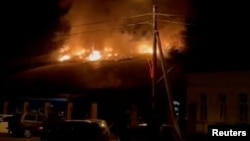Russia’s military said Tuesday its air defenses destroyed 13 Ukrainian aerial drones, while officials in Ukrainian regions along the border with Russia reported damage from Russian shelling.
The Russian Defense Ministry said nine drones were destroyed over the Rostov region, where officials said the Ukrainian attacks caused no casualties.
Russia also reported intercepting Ukrainian drones over the Belgorod, Kursk and Voronezh regions, as well as over the Black Sea near Russia-occupied Crimea.
In Kursk, Governor Alexey Smirnov said a Ukrainian aerial attack caused a fire at a factory that produces electrical devices in the town of Korenevo. No workers at the site were hurt, Smirnov said on Telegram.
Belgorod Governor Vyacheslav Gladkov said Tuesday on Telegram that Ukrainian attacks damaged buildings in several villages and injured at least eight people.
Ukraine’s military said Tuesday it destroyed two attack drones and eight reconnaissance drones.
Serhiy Lysak, governor of Ukraine’s Dnipropetrovsk region, posted on Telegram that Ukrainian air defenses downed a Russian drone in the area overnight.
Kherson Governor Oleksandr Prokudin said on Telegram that Russian shelling hit the region and a Russian missile attack damaged two hangars and several other buildings.
Officials in the Mykolaiv and Kharkiv regions also reported Tuesday that their areas had come under Russian shelling.
On Tuesday, Britain initiated a review of its armed forces, led by former NATO chief George Robertson, who cautioned that the world is confronted with a “deadly quartet” of China, Russia, Iran and North Korea.
This assessment, commissioned by Prime Minister Keir Starmer shortly after his return from a NATO summit, will outline a strategy to increase defense spending to 2.5% of GDP.
The Ministry of Defense announced that the Strategic Defense Review would commence “immediately in recognition of the urgency of the threats facing the U.K.” with a report expected in the first half of 2025.
At the NATO summit in Washington last week, Starmer reiterated the U.K.’s backing for the Western military alliance and emphasized its “strong commitment” to allocating 2.5% of its GDP for defense.
On Tuesday, the Kremlin responded cautiously to Ukrainian President Volodymyr Zelenskyy’s apparent invitation for a future peace summit, stating that Russia needs to clarify Kyiv’s intentions before engaging in discussions.
Zelenskyy mentioned on Monday that Russia should participate in a second summit concerning the war in Ukraine, marking a shift from last month when Kyiv excluded Moscow from a high-level peace conference in Switzerland.
“The first peace summit was not a peace summit at all. So perhaps it is necessary to first understand what he means,” said Kremlin spokesperson Dmitry Peskov to the Zvezda television channel.
The summit was in June at the Swiss resort of Burgenstock. The two countries are vastly different in their positions regarding the terms for a potential peace agreement to end the conflict, which has persisted for more than two years.
Moscow maintains that it must retain all territory it currently occupies, which amounts to 20% of Ukraine, while Kyiv demands the withdrawal of all Russian troops from its internationally recognized borders, including Crimea, which was annexed by Russia in 2014.
On Monday, Washington voiced its support for Ukraine’s choice to invite Russia to a second summit but raised concerns about Moscow’s willingness to engage in discussions.
Before last month’s summit, Russian President Vladimir Putin said he was open to negotiations and would declare a cease-fire immediately if Kyiv surrendered the territories Moscow claims.
There is increasing concern in Kyiv regarding the long-term direction of the conflict, especially considering Russia’s recent military advances and the possibility of Donald Trump winning the U.S. presidential election in November.
On Monday, Zelenskyy expressed that he was “not worried” about the chance of Trump winning, affirming his reliance on continued support from the United States, Ukraine’s largest financial and military supporter.
On Tuesday, EU finance ministers criticized Hungary, emphasizing during heated discussions in Brussels that supporting Ukraine should be a priority during its presidency of the bloc.
Hungary’s actions have frustrated its EU partners, particularly following Prime Minister Viktor Orban’s recent visit with Putin in Russia.
In response, Brussels announced on Monday that senior European Commission officials will not visit Hungary for meetings throughout its six-month EU presidency.
Tensions were high as about 20 finance ministers criticized Hungary during their regular meeting in Brussels on Tuesday.
Swedish Finance Minister Elisabeth Svantesson expressed anger and disappointment over the start of Hungary’s EU presidency, particularly after Orban’s visit to Moscow, which she deemed an insult to Ukraine and the other EU member states.
Orban’s described his trip to Moscow on July 5 as a “peace mission.” He has also traveled to Kyiv and Beijing and met with Trump.
Hungary’s EU partners were upset that Orban seemed to leverage his presidency to legitimize his international visits.
While Hungary’s Finance Minister Mihaly Varga outlined seven priorities for the presidency, the lack of a strong commitment to supporting Ukraine was met with criticism.
Dutch Minister Eelco Heinen emphasized the importance of unity among EU nations in their backing for Ukraine, a stance Hungary has previously hindered by blocking sanctions against Russia and aid for Ukraine.









